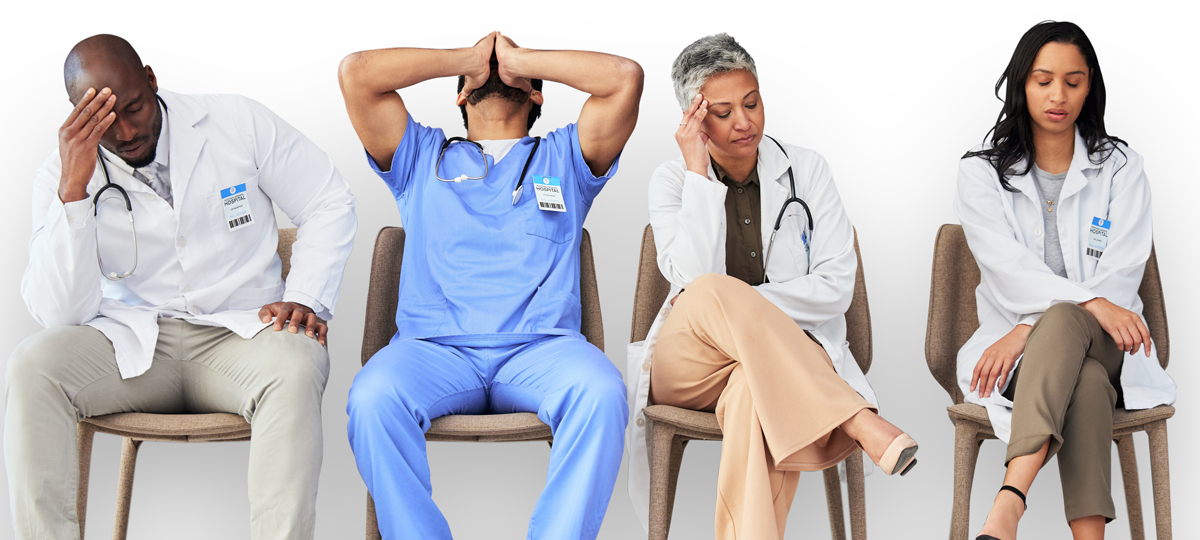Massage Therapy Journal
The Science of Stress
Learn more about what science is telling us about how the body responds to stress, and how massage therapy may help.
Can massage therapy reduce occupational stress for health care workers?
By Martha Brown Menard, Ph.D., LMT, August 1, 2023

Does massage therapy or other forms of physical relaxation reduce occupational stress for health care workers?
Chronic exposure to work related stressors such as long hours and job strain is well known to have negative effects on physical and mental health. Health care workers are an especially vulnerable group, with stressful environments and work pressure often leading to burnout, a situation exacerbated during the Covid-19 pandemic.
While cognitive approaches such as mindfulness and cognitive behavioral therapy have demonstrated benefits for stress reduction, physical approaches such as yoga, progressive muscle relaxation and massage therapy have not been studied as extensively. This study provides an updated systematic review and meta‐analysis of all randomized controlled trials using physical methods of relaxation in health care workers on occupational stress reduction.
This meta‐analysis was conducted using PRISMA (Preferred Reporting Items for Systematic Review and Meta‐analyses) guidelines. Inclusion criteria were randomized controlled trials employing physical relaxation methods compared to non‐intervention control or other physical relaxation methods for occupational stress in health care workers, with change from baseline or both pre‐ and post‐intervention stress data at any duration of follow‐up.
Physical relaxation was defined as any method that involved light muscular tension and relaxation, including movement‐based techniques such as yoga and related exercises, stretching, and walking, as well as passive techniques such as massage and progressive muscle relaxation. Vigorous exercise, such as heavy aerobic activity and weightlifting, was excluded. Techniques devoid of muscular activity, such as aromatherapy without massage and music therapy, were also excluded.
The PubMed, SCOPUS, Web of Science and the Cochrane Library databases from inception to February 21, 2021 were searched. A manual search of references in pertinent review articles in this area was also conducted. Exclusion criteria were non‐randomized-controlled trials such as quasi‐randomized and quasi‐experimental studies, lack of a non‐intervention or another physical relaxation comparison group, lack of stress assessment data or data that was otherwise insufficient for extraction, studies involving rigorous physical exercise or strength training, studies on subjects with preexisting mental illness, articles without full‐text, and non‐English manuscripts.
Two authors independently extracted data from all studies deemed eligible for inclusion, with disagreements addressed through discussion until consensus was reached. For the primary outcome of stress, mean changes of stress scores and standard deviation from baseline for both arms were used. When multiple scales were used, preference was given to measures more specific for stress and those more commonly used in other identified studies, including the Perceived Stress Scale (PSS), the Maslach Burnout Inventory for emotional exhaustion (MBI‐EE) and the Nursing Stress Scale (NSS). A secondary outcome was mean changes in assessments examining mental and physical health.
Two authors independently assessed the quality of included RCTs with the Cochrane Collaboration’s Risk of Bias tool. Manuscripts were evaluated on five domains of bias: randomization process, deviations from intended interventions, missing outcome data, measurement of the outcome, and selection of the reported result. Disagreements were resolved through discussion until consensus was reached. Statistical analysis was performed with the meta‐package in RStudio version 1.4.1106. To compare various methods of physical relaxation to each other, a random‐effects frequentist network meta‐analysis was conducted with the R package netmeta.
The authors identified 3414 articles from databases, with another 37 through manual searching of review articles. After screening, 15 studies were included in the final analysis. A total of 688 subjects were enrolled across the 15 studies, with 341 participants having undergone physical relaxation compared to 347 non‐intervention controls. Of those, 139 were involved in yoga or a yoga like exercise (Tai Chi and qigong); 167 received some type of massage therapy; 15 were engaged in progressive muscle relaxation (PMR); and 20 performed stretching exercises. All studies were assessed as having some degree of bias. Massage protocols used in these studies ranged from a single session of a 10-minute seated massage to multiple 90-minute sessions of aromatherapy massage over 6 weeks. The most common health care profession represented was nursing.
Pooled results show that all interventions involving yoga (seven trials), massage therapy (six trials), PMR (one trial), and stretching exercises (one trial) significantly reduced measures of occupational stress at the longest duration of follow‐up vs baseline compared to non‐intervention controls, with p < .00001. Yoga was found to rank the highest in effectiveness, followed by massage therapy, PMR, stretching and finally no intervention. In the network analysis, both yoga alone and massage therapy alone significantly reduced measures of occupational stress compared to a non‐intervention control at the longest duration of follow‐up vs. baseline.
A wide variety of massage approaches and lengths were included across the different studies, which may have made statistical effects harder to demonstrate. No information regarding the training or experience of the massage practitioners was included.
Systematic reviews and meta-analyses of RCTs are considered to be among the strongest types of studies to show a cause and effect relationship. A massage therapist could credibly cite this study in support of a massage program for nurses in the workplace as part of an organization effort to reduce stress and avoid burnout.
The Science of Stress
Learn more about what science is telling us about how the body responds to stress, and how massage therapy may help.
4 Fallacies About Research and Massage
Navigate the rough landscape between research and massage fact and fiction.
1. Zhang M, Murphy B, Cabanilla A, Yidi C. “Physical relaxation for occupational stress in healthcare workers: A systematic review and network meta-analysis of randomized controlled trials.” J Occup Health. 2021 Jan;63(1):e12243.